The Chariot of God
by Jeffrey J. Harrison
According to the rabbis, there is one chapter in the Bible that is so dangerous, it is forbidden to be taught to groups of disciples. It can only be taught to one student at a time, and only if he is a mature student (Hagigah 2:1). This chapter is so dangerous, it is forbidden to be read in the regular synagogue service. It led some of Israel’s most famous rabbis to engage in strange mystical practices: practices that killed one of them, made another crazy, and led another into heresy (Hagigah 14b).* For hundreds of years, even the name of this chapter caused knowledgeable Jews to shudder. What chapter is this? They call it the Merkabah: the Chariot (Ezekiel 1).
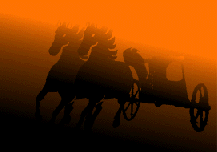
* These mystical practices were called descending to the Chariot.
They included fasting, special hymns or prayers recited with their heads between their knees, and the invocation of God or the angels with special names. Many believe that the companion of Rabbi Akiva that left Judaism as a result of this experience became a Christian.
The chariot was a powerful religious symbol for ancient Israel: not the ordinary chariots used for war, but what the Bible calls chariots of fire.
The first mention of chariots of fire is in 2 Kings 2:11. This is the story of Elijah being caught up into heaven. Tradition imagines that it was the chariot itself that carried Elijah away, as in the well-known spiritual, Swing Low, Sweet Chariot.
But the Bible says that the chariot only served to separate Elijah from Elisha. It was actually a strong storm-wind (a se‘arah סְעָרָה) that snatched Elijah away. Who was driving the chariot? It doesn’t say—very mysterious.
The next mention of chariots of fire is in 2 Kings 6:17. Elisha, now a famous prophet in his own right, was trapped by the army of the Arameans in the small town of Dothan, at the edge of Galilee. The Arameans were the enemy of Israel, ruling from Damascus, just as the Syrians do today. They had come to Dothan to capture Elisha. Why? Because he was constantly defeating their secret war plans by revealing them to the king of Israel.
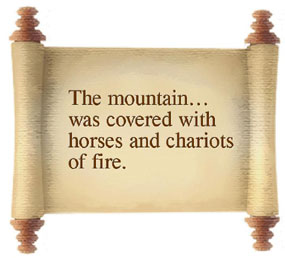
The sight of this vast enemy army greatly frightened Elisha’s servant. So Elisha prayed for the servant’s spiritual eyes to be opened. When they were, he saw the mountain on which the city was built covered over with horses and chariots of fire. God’s angelic army was protecting them from the enemy.
The book of Psalms also mentions chariots of fire in talking about God’s overwhelming power: The chariots of God are tens of thousands, thousands of times over. The Lord is with them, as at Sinai in holiness
(Psa. 68:17).
But perhaps the strangest mention of a chariot in the Bible is in 1 Chronicles 28:18. This section gives the details of King David’s plans for the construction of the Temple, later built by Solomon, his son. But in the plans for the innermost chamber of the Temple—the Holy of Holies—not only was there going to be the ark of the covenant. There would also be a golden chariot (a merkabah). What is a chariot doing in the holiest part of the Temple? A careful reading of the verse shows that it had something to do with the two large angels (the cherubim) that Solomon placed in the Holy of Holies, whose wings, from the wingtips of one to the wingtips of the other, stretched across that innermost chamber (1 Kings 6:23-28). But why a chariot?
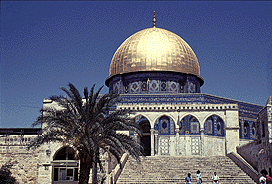
The answer was discovered a few years ago by an archeologist, Leen Ritmeyer, while he was flying at 30,000 feet from the U.S. to Israel. He got bored with the in-flight movie, and took out his plans of the ancient Temple Mount in Jerusalem. He had been studying the large piece of bedrock that sticks up six feet above floor level under the central dome of the Dome of the Rock, the gold-domed Muslim shrine that stands in the middle of the ancient Temple site. Many have speculated that this rock was once the location of the Holy of Holies. But no one had ever been able to prove it—until now.
On the basis of natural rock contours and marks in the rock, he had already been able to locate the walls of an ancient room once built there. The measurements of this room were exactly the same as the Holy of Holies in the Temple of Solomon: twenty cubits square (1 Kings 6:20).* But now, as he looked at a photo of the rock, he noticed a small depression, exactly in the center of this ancient room. No one had paid much attention to it before, because of all the other cuts and marks in the rock. But when he measured it, he was amazed to find that this depression had the same dimensions as the ark of the covenant: 2.5 cubits long and 1.5 cubits wide! (Exo. 25:10) Perhaps this was the very place
that Solomon had prepared in which to set the ark (2 Chron. 5:7).
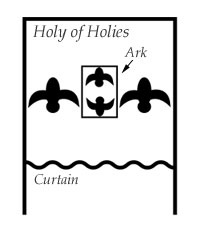
Covenant in the Holy of Holies
* A cubit is the distance from the elbow to the tip of the middle finger, about 17.5 inches or 44.5 cm. This makes the size of the Holy of Holies about 29 foot square or 8.9 meters square.
There was a problem, though: the depression was facing the wrong way. We usually picture the ark with its broad side facing towards us, and with the two small golden angels (the two small cherubim) attached to its lid on the right and on the left. But the depression in the rock was going the other way, with the narrow end facing out. Now that was really odd. Why would the narrow end of the ark face outward? And then it hit him. Of course! That was the way the ark faced when it was carried before the people in the time of Moses and Joshua. They would naturally have put the ark in the Temple facing the same way: to show God leading the way before his people. In fact, this is the only way to make sense of the fact that when they first put the ark in the Temple, the poles used to carry it stuck out from the Holy of Holies (1 Kings 8:8). This wouldn’t have happened if the ark had been put in sideways, as we usually picture it.
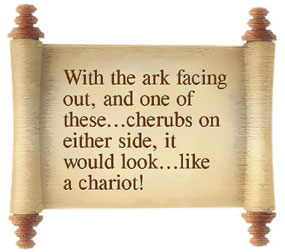
But what does all this have to do with a chariot? As we said, Solomon built two huge angels that stood at the sides of the ark. These angels were not beautiful women with wings, as we often picture them. Lady angels were a pagan idea picked up much later by Christian artists. In the Bible, angels appear either as men, when they appear on earth, or as ferocious beasts—part lion, part bull, etc.— when they appear in visions. These strange and frightening animal-type angels were not unique to ancient Israel. This same imagery was shared by all the surrounding nations. Many, many pieces of ancient art have been found showing this animalistic type of cherub. This means that with the ark’s narrow end facing out, and one of these large animal-like cherubs on either side, it would not just look like they were standing next to the ark, but that they were pulling it—like a chariot!
This idea is not strange to the Bible. One of the oft-repeated descriptions of God is that he sits on the cherubs, or rides on them (2 Kings 19:15, Psa. 80:1, Psa. 99:1, 2 Sam. 22:11, Psa. 18:10). The ark flanked by animal-like cherubs is the chariot of God!
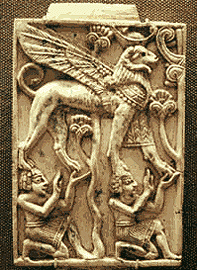
So now you’re ready for the chapter on the Chariot: that dangerous chapter I warned you about. This is the first vision that Ezekiel had when he was among the exiles from Judah in Babylon, a thousand miles from home.* One day, when he was outside by the river Chebar, he saw a storm-wind
(a se‘arah סְעָרָה) approaching (Eze. 1:4)—just like the one that had snatched Elijah away so many years earlier (2 Kings 2:11). But Ezekiel adds the word for Spirit
to his description of this wind, for this was clearly a storm of the Spirit (a ruach se‘arah רוּחַ סְעָרָה). In the storm he sees four terrifying cherubim, the same number surrounding the ark of the covenant in the Temple.** And beside each was a spinning wheel: the wheels of the chariot of God (Eze. 1:15).***
* In modern-day Iraq.
** Two small cherubs were part of the covering of the ark itself (from the time of Moses; Ex. 25:18-20), plus there were the two large ones on either side of the ark from the time of Solomon (1 Kings 6:23-28). See the line drawing above.
*** This Spirit-storm is not directly called a chariot in Ezekiel 1, but this is the traditional Jewish understanding: it was a vision of the chariot of God. A similar image appears in Psalm 104: He makes the clouds his chariot, who walks on the wings of the Spirit
(Psa. 104:3).
Above the heads of the cherubs was something like a glass ceiling (Eze. 1:22). And above that was something like a throne made of precious stone (Eze. 1:26). This detail should not be overlooked. Throughout the Bible, stone is associated with divinity, as often in the Psalms, The Lord is my rock, my fortress, and my deliverer
(Psa. 18:2, as Psa. 18:31,46; 19:14, 28:1, and many others). Over and over again the Bible identifies God the Father as the one seated on the throne, the invisible ruler of everything. But who now is this figure the prophet sees, that looks like a human being, sitting on the throne of God’s chariot, with legs like glowing metal and a radiance all around him? (Eze. 1:26-27)
The appearance of this luminous being is clearly the purpose and the climax of the vision. When Ezekiel sees him, he falls to his face, humbling himself in an attitude of worship (Eze. 1:28). But the figure on the throne commands him instead to rise. No sooner are these words spoken than the Holy Spirit enters Ezekiel and sets him on his feet (Eze. 2:2). The mysterious man then begins to speak to the prophet in the name and with the authority of God: I am sending you,
he says—without, like the angels, claiming to speak for another—and you will say to them,
(Eze. 2:4). Who is this that dares to speak with the authority of God? It couldn’t be God the Father himself, for the idea of the Father appearing in any particular form was unthinkable. God is Spirit, the Bible says, and so cannot be confined to any one time or place. So who is this? This is where it started to get dangerous for those rabbis.This is what the Lord God says
The identity of this mysterious being is given in Ezekiel 1:28, though it’s often obscured in translation. The original Hebrew says: He is the appearance of the likeness of the glory of God.
Does that sound familiar? It’s the verse that Hebrews 1:3 is referring to when it says, And he is the radiance of (God’s) glory and the exact representation of his nature.
Hebrews identifies this radiant one as Jesus, Yeshua, the Messiah. By alluding or hinting to Ezekiel, Hebrews interprets Ezekiel’s prophecy for us: Jesus is the one sitting on the throne who speaks as God and who is God. This is what made this chapter so dangerous to those early rabbis: because it is so clearly pointing to Jesus. The rabbi who left Judaism most likely realized that this was Jesus on the throne, and became a Christian. Do you know anyone today that has trouble accepting the tri-unity of God? Tell them about the one sitting in the chariot of God, who speaks as God, and is God!
In Ezekiel 1:27, it says that this human figure appeared like glowing metal. This is another detail that should not be overlooked. A radiant man with legs like glowing metal also appears in Daniel 10:6, and again in Revelation 1:15. Who is it? The same person: Jesus!—not as he appeared on earth in the humility of his humanity, but as he appears in heaven, filled with the power and the majesty of God. He is the appearance of the glory of God! This is how he also appeared to his disciples on the Mt. of Transfiguration: not as an ordinary man, but in the fiery power of God: his face radiant as the sun, his garments white as light (Matt. 17:2). He is the appearance of the glory of God. No wonder Ezekiel fell down in worship!
Ezekiel’s vision of the Chariot explains how the heavenly, timeless God, whom we cannot see (Exo. 33:20), is able to reveal himself to us: through his two arms
(Isa. 51:5)—the Son of God and the rushing storm-wind of the Spirit. They are sent from God, yet they are God himself. As Jesus said, He who has seen me has seen the Father.
So many think of God as restricted to heaven, cut off from life on earth. But the message of the Bible is that God gets around, and he’s coming in your direction. His storm-wind is approaching. His lightning bolts are crashing. His chariot wheels are grinding. And when he arrives, what will happen? Will it drive you crazy, or even kill you, like those rabbis of old? Or will you, like Ezekiel, bow down before the radiant man, receive his instruction, and be filled with his Spirit?